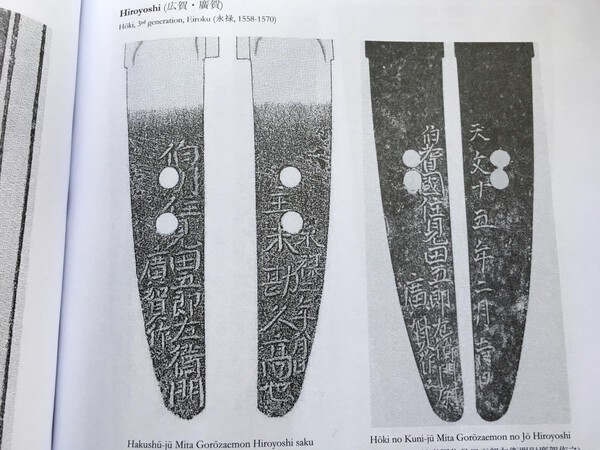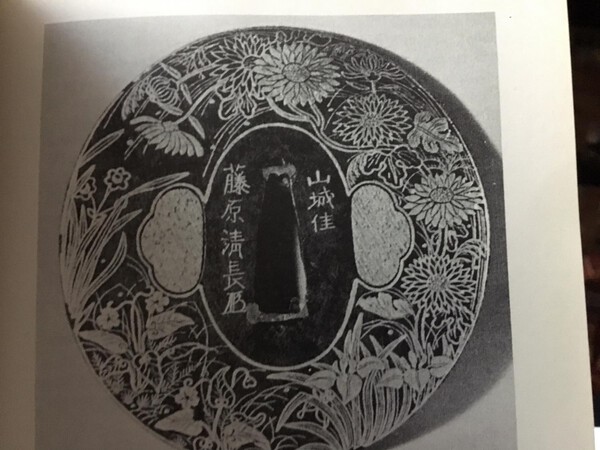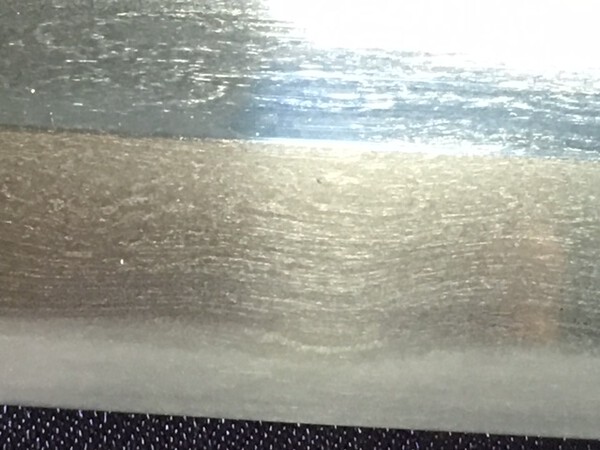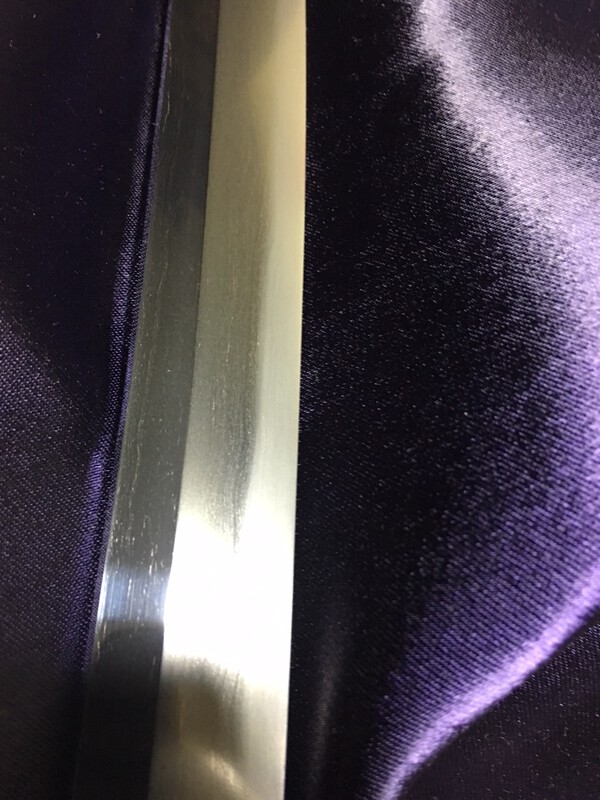-
Posts
2,871 -
Joined
-
Last visited
-
Days Won
12
Content Type
Profiles
Forums
Events
Store
Downloads
Gallery
Everything posted by Shugyosha
-
Hi Richard, I'm struggling with the photograph of the mei so take what follows in that context. I think I can make out 東 then there's a kanji I can't make out and then maybe 門. There were several smiths working in Bizen in the early to mid 17th century signing with 東多門兵 "Azuma Tamonbei" as part of their signature and it may be one of those. The work styles of these two might fit with the hamon I can see on this sword (From Sesko's Swordsmiths of Japan): MASANARI (正成), Kan´ei (寛永, 1624-1644), Bizen – “Azuma Tamonbei Fujiwara Masanari kore o saku” (東多門兵衛藤原正成作之), “Bizen no Kuni Okayama-jū Azuma Tamonbei Fujiwara Masanari” (備前国岡山住 東多門兵衛藤原正成), real name Azuma Tamonbei (東多門兵衛, the family name can also read Tō or Higashi), gunome-chōji, suguha with ashi, we know blades from the Kan´ei to the Keian era (慶安, 1648-1652), chūjō-saku MASATSUGU (正次), Manji (万治, 1658-1661), Bizen – “Azuma Tamonbei Masatsugu” (東多門兵衛正次), “Bishū Okayama-jū Azuma Tamonbei Masatsugu” (備州岡山住東多門兵衛正次), “Azuma Tamonbei no Jō Fujiwara Masatsugu” (東多門兵衛尉藤原正次), real name Azuma Tamonbei (東多門兵衛, the family name can also read Tō or Higashi), son of Azuma Masanari (正成), itame, gunome-midare mixed with chōji, chū-saku Best, John
-
Hi Tom, Here comes the hail Mary: 伯耆? 廣賀 Hoki ? Hiroyoshi There were a bunch of guys signing like this working from the mid 15th to the mid 17th centuries so it might be one of the koto smiths as per John's post. Just to emphasise, this is a very long shot and, even if I've read this accurately which I seriously doubt, the value of kinpun mei is dependent on the knowledge and bona fides of the guy doing the writing. The examples of nakago jiri that I've been able to find don't match this they are more kurijiri but I'm not sure that the one on this sword is necessarily original as it has clearly been shortened at some point and the closeness of a couple of mekugi ana might suggest that adjustments have been made to make it fit a koshirae rather than the other way around. There is, however, a slight curvature to the ha side of the nakago though, which seems to be present on the original part of the tang on Tom's sword. I've added a couple of examples, though it's a small group so maybe not representative. I'm not sure if this adds up to anything other than get a better opinion than mine. Maybe someone at the New York sword society can help - perhaps not too far from where you are in New Jersey. Good luck and let us know the outcome, John
-
或遭王難苦 臨刑欲壽終 念彼觀音力 刀尋段段壞 Having found the last four kanji and googled the above magically appeared. It gets a lot of hits so I think its fairly well known and linked to Bhuddism. I don't have time to do a proper translation now but I think it hints at the sword being used to gradually break down ignorance and bring about enlightenment.
-
Bizen Kuni Osafune... Best, John
-
Alex, You need to stop using Google translate - what you are writing makes no sense in English.
-
Bang on the money...
-
Sergei, This isn't rocket science - it can be a bit tricky but you can handle it. Spend an hour reading around how to count the strokes in kanji and how the radicals work and it will give you the nuts and bolts. After that just try to do a couple every day - the Aoi website is good as the items are described in Japanese and English so you can take a stab and then check and correct yourself. Have fun!!
-
I read that the 2nd and 8th months were considered auspicious by sword smiths because of the way the numbers are written in Japanese: 二 八 They imply something being cut or cloven horizontally and vertically. Is that just apocryphal?
-
Hi Peter, It has been a while but I found an entry in an old book which I think is of a tsuba by the guy who made yours signed "Yamashiro Ju Fujiwara Kiyonaga with Kao" (photo attached) and the corresponding entry in Haynes. I think that might solve our respective mysteries. Best, John
-
Rai Kunimitsu or a banana. You're not coming through very clearly.
-
Hi Marius, I think we can take this up a level - how about you think of a sword and I have to guess what you're thinking? Best, John
-
Sorry other John, my bid was for the one working after Kanbun - Markus Sessko lists him as being first generation. The one thing I am confident of is that this is a shinto blade...
-
-
Hi John, I wasn't certain, but I've now had a double-check in Sessko and found: MORITATSU (盛龍・盛竜) → KOREYOSHI (惟義), Shōwa (昭和, 1926-1989), Kumamoto KOREYOSHI (惟義), Shōwa (昭和, 1926-1989), Kumamoto – “Koreyoshi” (惟義), “Higo Kikuchi-jū Koreyoshi Minamigawa-satetsu o motte kore o kitae” (肥後菊池住惟義以南川砂鉄 鍛之, “forged by Koreyoshi from Higo´s Kikuchi by using satetsu from the Minamigawa”), real name Ōtsuka Koreyoshi (大塚惟義), born December 24th 1916, he studied during World War II under Kongōbei Moritaka Yasuhiro (金剛兵衛 盛高靖博) and worked then as rikugun-jumei-tōshō, he had signed in his earlier years with Moritatsu (盛竜).
-
Hi Simon, I think it's Tatsu 龍. Best, John
-
It’ll take far less than togariba to fool me!!
-
Hi Matthew, Length is also a significant factor in dating a tanto - if you are able to measure the cutting edge that might give an idea. I'm trying to remember where I saw a chart of the various tanto shapes/ lengths related to era and set out for comparison...might have been on here...?? Best, John
-
I'll take a put at the first generation Kashu Kiyomitsu.
-
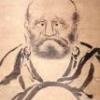
Hasebe Kunishige? Your Thoughts Please
Shugyosha replied to mareo1912's topic in General Nihonto Related Discussion
Something seems off about the sugata to me. It seems too slender and the point too small by comparison to other Hasebe work. Here's a link to a tanto that Darcy had by Kunishige which also has a picture of Hasebe Heshikiri for comparason of the sugata: http://www.nihonto.ca/hasebe-kunishige-2/index.html Also here's another Hasebe blade that Darcy had for sale: http://www.nihonto.ca/index.html But that said, it is a small sample so it might not tell the full story. -

Help With Reading Sayagaki And Origami
Shugyosha replied to Krystian's topic in Translation Assistance
大和手掻包永の末文珠九郎三郎子 Yamato Tegai Kanenaga no tsue Monju Kurozaburo Ko. I think that this is a reference to being a descendant of Tegai Kanenaga and gives his real name - Monju Kurozaburo. -

Help With Reading Sayagaki And Origami
Shugyosha replied to Krystian's topic in Translation Assistance
Ray beat me to it but I'll post anyway: The origami reads "one katana, mumei, Monju (文珠). The saya gaki is more specific: 南紀文珠重国 (Nanki Monju Shigekuni) Kanbun Goro (寛文頃) - around Kanbun. Best, John -
Sorry - you're absolutely correct - that's me automatically associating mizukage with saiha. The Shimada school isn't one I really know anything about. I've had a look at some examples and I think the hada and jinie would certainly support your kantei. Thanks again for posting - I've learned something from that. Best, John
-
Me neither - I would have given it to Shinto and probably will if I see it again.
-
Hi Luis, In England we have a saying that "rules are for the guidance of the wise and for the governance of fools". I'm not suggesting that you are a fool (whereas in Nihonto terms I certainly am) but learning the rules is only the beginning... Best, John



